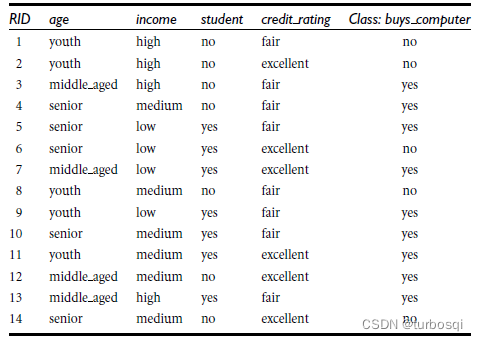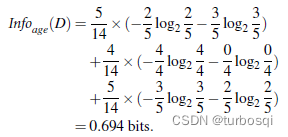机器学习-基础知识
机器学习-线性回归
机器学习-逻辑回归
机器学习-聚类算法
机器学习-决策树算法
机器学习-集成算法
机器学习-SVM算法
文章目录
1. 决策树算法
1.1. 什么是决策树/判定树
决策树是一个类似于流程图的树结构,其中,每个内部结点表示在一个属性上的测试,每个分支代表一个属性输出,而每个树叶结点代表类或类的分布,树的顶层是根结点。决策树是一种有监督学习的一种算法,是机器学习中分类方法中的一个重要分支。
1.2. 决策树归纳算法

-
策略:
- 自根至叶的递归过程,在每个中间结点寻找一个"划分"属性;
- 开始构建根结点,所有训练数据都放在根结点,选择一个最优特征,按照这一特征将训练集分割成子集,进入子结点;
- 所有子集按内部结点的属性递归的进行分割;
- 如果这些子集已经能够被基本正确分类,那么构建叶结点,并将这些子集分到所对应的叶结点上去;
- 每个子集都被分到叶结点上,即都有了明确的类,这就生成了一颗决策树。
三种停止条件:
- 当前结点包含的样本全属于同一个类别,无需划分;
- 当前属性集为空,或者所有样本在所有属性上取值相同,无法划分;
- 当前结点包含的样本集合为空,不能划分。
1.3. 熵概念
-
用比特
(bit)来衡量信息的多少熵:
H ( x ) = − ∑ x P ( x ) l o g 2 [ P ( x ) ] H(x)=- \sum_{x}{P(x)log_2[P(x)]}\quad\quad\quad\quad\quad\quad\quad\quad\quad\quad\quad\quad\quad\quad\quad\quad\quad\quad\quad H(x)=−x∑P(x)log2[P(x)]
变量的不确定性越大,熵就越大。信息的获取量:
G a i n ( A ) = I n f o ( D ) − I n f o r A ( D ) Gain(A) = Info(D) - Infor_A(D)\quad\quad\quad\quad\quad\quad\quad\quad\quad\quad\quad\quad\quad\quad\quad\quad\quad Gain(A)=Info(D)−InforA(D)
1.4. 具体算法
- ID3算法





对于以上的四个属性中,最大的信息熵为age,所以选择age作为第一个分支,建立决策树

具体的实现过程:

-
CART算法
反映了从D中随机抽取两个样例,其类别标记不一致的概率
Gini(D)越小,数据集D的纯度越高
G i n i ( D ) = ∑ k = 1 ∣ y ∣ ∑ k ′ ≠ k p k p k ′ = 1 − ∑ k = 1 ∣ y ∣ p k 2 Gini(D)=\sum_{k=1}^{|y|}\sum_{k^{'}\neq k}{p_kp_k{'}}=1-\sum_{k=1}^{|y|}{p_k^2} \quad\quad\quad\quad\quad\quad\quad\quad\quad\quad\quad\quad\quad Gini(D)=k=1∑∣y∣k′=k∑pkpk′=1−k=1∑∣y∣pk2
属性a的基尼指数:
G i n i _ i n d e x ( D , a ) = ∑ v = 1 V ∣ D v ∣ ∣ D ∣ G i n i ( D v ) Gini\_index(D,a)=\sum_{v=1}^{V}\frac{|D^v|}{|D|} Gini(D^v)\quad\quad\quad\quad\quad\quad\quad\quad\quad\quad\quad\quad\quad Gini_index(D,a)=v=1∑V∣D∣∣Dv∣Gini(Dv)
在候选属性集合中,选取那个使划分后基尼系数最小的属性
具体计算过程:

-
增益率-C4.5算法
信息增益:对可取值数目较多的属性有所偏好(缺点)
G i n i _ r a t i o ( D , a ) = G a i n ( D , a ) I V ( a ) Gini\_ratio(D,a)=\frac{Gain(D,a)}{IV(a)} \quad\quad\quad\quad\quad\quad\quad\quad\quad\quad\quad\quad\quad Gini_ratio(D,a)=IV(a)Gain(D,a)
增益率:
I V ( a ) = − ∑ v = 1 V ∣ D v ∣ ∣ D ∣ l o g 2 ∣ D v ∣ ∣ D ∣ IV(a)=-\sum_{v=1}^{V}\frac{|D^v|}{|D|}log_2\frac{|D^v|}{|D|} \quad\quad\quad\quad\quad\quad\quad\quad\quad\quad\quad\quad\quad\quad\quad IV(a)=−v=1∑V∣D∣∣Dv∣log2∣D∣∣Dv∣- 属性
a的可能取值数目越大(即V越大),则IV(a)的值通常就越大 - 启发式:先从候选划分属性中找出信息增益高于平均水平的,再从中选取增益率最高的
- 属性
1.5. 决策树剪枝
-
剪枝:防止决策树过拟合
-
基本策略:
-
预剪枝:提前终止某些分支的生长
限制深度,叶子结点个数,叶子结点的样本数,信息增益等
-
后剪枝:生成一棵完全树,再回头剪枝
通过一定的衡量标准: C α ( T ) = C ( T ) + α ⋅ ∣ T l e a f ∣ C_ \alpha (T)=C(T)+ \alpha \cdot |T_{leaf}| Cα(T)=C(T)+α⋅∣Tleaf∣
-
-
优缺点:
-
时间开销:
- 预剪枝:训练时间开销降低,测试时间开销降低
- 后剪枝:训练时间开销增加,测试时间开销降低
-
过/欠拟合风险:
- 预剪枝:过拟合风险降低,欠拟合风险增加
- 后剪枝:过拟合风险降低,欠拟合风险不变
-
泛化性能:
后剪枝通常由于预剪枝
-
1.6. 连续值与缺失值处理
1.6.1. 连续值处理
- 连续值处理:由于连续属性的可取值数目不再有限,因此不能直接根据连续属性的可取值来对结点进行划分。
- 基本思路:连续属性离散化
- 常见做法:二分法
1.6.2. 缺失值处理
- 基本思路: 样本赋权,权重划分
1.7. 决策树算法的优缺点
- 优点:
- 速度快:计算量相对较少,且容易转化为分类规则。只要沿着树根向下一直走到叶,沿途的分裂条件就能唯一确定一条分类的谓词。
- 准确性高:挖掘出来的分类规则准确性高,便于理解,决策树可以清晰的看到哪些字段比较重要
- 非参数学习,不需要设置参数
- 缺点:
- 缺乏伸缩性:由于进行深度优先搜索,所以算法受内存大小限制,难于处理大训练集。
- 为了处理大数据集或连续值的种种改进算法(离散化、取样)不仅增加了分类算法的额外开销,而且降低了分类的准确性,对连续性的字段比较难预测,当类别太多时,错误可能就会增加的比较快,对有时间顺序的数据,需要很多预处理的工作。
1.8. 决策树算法的具体实现
1.8.1. 使用sklearn工具包实现
from sklearn.feature_extraction import DictVectorizer
# 读取和写入csv文件时用到
import csv
# 导入决策树模块
from sklearn import tree
# 导入数据预处理模块
from sklearn import preprocessing
# 读取csv文件,并将特征放入dict列表和类标签列表中
allElectronicsData = open("注意:文件路径",'rt')
reader = csv.reader(allElectronicsData)
headers = next(reader)
print(headers)
# 保存前面的属性组
featureList = []
# 保存后面的标签分类
labelList = []
for row in reader:
labelList.append(row[len(row)-1])
rowDict = {}
for i in range(1,len(row)-1):
rowDict[headers[i]] = row[i]
featureList.append(rowDict)
print(featureList)
# 数据预处理,把分类数据二值化
vec = DictVectorizer()
dummyx = vec.fit_transform(featureList).toarray()
print("dummyX:" + str(dummyx))
print(vec.get_feature_names_out())
print("labelList:" + str(labelList))
lb = preprocessing.LabelBinarizer()
dummyY = lb.fit_transform(labelList)
print("dummyY:" + str(dummyY))
# 创建决策树分类的对象
clf = tree.DecisionTreeClassifier(criterion='entropy')
clf = clf.fit(dummyx,dummyY)
# 可视化模型
with open("注意:文件路径", 'w') as f:
f = tree.export_graphviz(clf, feature_names=vec.get_feature_names_out(), out_file=f)
# 测试集进行验证
oneRowW = dummyx[0,:]
print("oneRowX:" + str(oneRowW))
# 把数据集中的年龄改为中年
newRowX = oneRowW
newRowX[0] = 1
newRowX[2] = 0
print("newRowX:" + str(newRowX))
newRowX = [newRowX]
predictedY = clf.predict(newRowX)
print("predictedY:" + str(predictedY))
结果展示:

1.8.2. 模拟实现
- 导包操作
import matplotlib.pyplot as plt
from math import log
import operator
- 算法模拟核心
def createDataSet():
dataSet = [[0, 0, 0, 0, 'no'],
[0, 0, 0, 1, 'no'],
[0, 1, 0, 1, 'yes'],
[0, 1, 1, 0, 'yes'],
[0, 0, 0, 0, 'no'],
[1, 0, 0, 0, 'no'],
[1, 0, 0, 1, 'no'],
[1, 1, 1, 1, 'yes'],
[1, 0, 1, 2, 'yes'],
[1, 0, 1, 2, 'yes'],
[2, 0, 1, 2, 'yes'],
[2, 0, 1, 1, 'yes'],
[2, 1, 0, 1, 'yes'],
[2, 1, 0, 2, 'yes'],
[2, 0, 0, 0, 'no']]
labels = ['F1-AGE','F2-WORK','F3-HOME','F4-LOAN']
return dataSet,labels
def createTree(dataset,labels,featLabels):
"""
dataset:数据集
labels:最终的标签的分类
featLabels: 标签的顺序
"""
# 把数据集最后一列的值存入classList
classList = [example[-1] for example in dataset]
# 当样本的标签全部一样时,就会相等
if classList.count(classList[0]) == len(classList):
return classList[0]
# 当前数据集中只剩下一类标签,此时已经遍历完了所有的数据集
if len(dataset[0]) == 1:
return majorityCnt(classList)
# 选择最优的特征,对应索引值
bestFeat = chooseBestFeatureToSplit(dataset)
# 找到实际的名字
bestFeatLabel = labels[bestFeat]
featLabels.append(bestFeatLabel)
myTree = {bestFeatLabel:{}}
del labels[bestFeat]
featValue = [example[bestFeat] for example in dataset]
# 得到不同的分支
uniqueVals = set(featValue)
for value in uniqueVals:
# 递归运行过程中,标签值的更替
sublabels = labels[:]
myTree[bestFeatLabel][value] = createTree(splitDataSet(dataset,bestFeat,value),sublabels,featLabels)
return myTree
def majorityCnt(classList):
"""计算哪一个类最多的"""
classCount = {}
for vote in classList:
if vote not in classCount.keys():classCount[vote] = 0
classCount[vote] += 1
# 排序后的结果
sortedclassCount = sorted(classCount.items(),key=operator.itemgetter(1),reverse=True)
return sortedclassCount[0][0]
def chooseBestFeatureToSplit(dataset):
numFeatures = len(dataset[0]) - 1
baseEntropy = calcShannonEnt(dataset)
# 最好的信息增益
bestInfoGain = 0
# 最好的特征
bestFeature = -1
for i in range(numFeatures):
featList = [example[i] for example in dataset]
uniqueVals = set(featList)
newEntropy = 0
for val in uniqueVals:
subDataSet = splitDataSet(dataset,i,val)
prob = len(subDataSet)/float(len(dataset))
newEntropy += prob * calcShannonEnt(subDataSet)
infoGain = baseEntropy - newEntropy
if infoGain > bestInfoGain:
bestInfoGain = infoGain
bestFeature = i
return bestFeature
def splitDataSet(dataset,axis,val):
retDataSet = []
for featVec in dataset:
if featVec[axis] == val:
reducedFeatVec = featVec[:axis]
reducedFeatVec.extend(featVec[axis+1:])
retDataSet.append(reducedFeatVec)
return retDataSet
def calcShannonEnt(dataset):
"""最开始时候的熵值"""
numexamples = len(dataset)
labelCounts = {}
# 先进行统计
for featVec in dataset:
currentlabel = featVec[-1]
if currentlabel not in labelCounts.keys():
labelCounts[currentlabel] = 0
labelCounts[currentlabel] += 1
shannonEnt = 0
for key in labelCounts:
prop = float(labelCounts[key])/numexamples
shannonEnt -= prop*log(prop,2)
return shannonEnt
- 画图操作
def getNumLeafs(myTree):
numLeafs = 0
firstStr = next(iter(myTree))
secondDict = myTree[firstStr]
for key in secondDict.keys():
if type(secondDict[key]).__name__=='dict':
numLeafs += getNumLeafs(secondDict[key])
else: numLeafs +=1
return numLeafs
def getTreeDepth(myTree):
maxDepth = 0
firstStr = next(iter(myTree))
secondDict = myTree[firstStr]
for key in secondDict.keys():
if type(secondDict[key]).__name__=='dict':
thisDepth = 1 + getTreeDepth(secondDict[key])
else: thisDepth = 1
if thisDepth > maxDepth: maxDepth = thisDepth
return maxDepth
def plotNode(nodeTxt, centerPt, parentPt, nodeType):
arrow_args = dict(arrowstyle="<-")
#font = FontProperties(fname=r"c:\windows\fonts\simsunb.ttf", size=14)
createPlot.ax1.annotate(nodeTxt, xy=parentPt, xycoords='axes fraction',
xytext=centerPt, textcoords='axes fraction',
va="center", ha="center", bbox=nodeType, arrowprops=arrow_args)#, FontProperties=font
def plotMidText(cntrPt, parentPt, txtString):
xMid = (parentPt[0]-cntrPt[0])/2.0 + cntrPt[0]
yMid = (parentPt[1]-cntrPt[1])/2.0 + cntrPt[1]
createPlot.ax1.text(xMid, yMid, txtString, va="center", ha="center", rotation=30)
def plotTree(myTree, parentPt, nodeTxt):
decisionNode = dict(boxstyle="sawtooth", fc="0.8")
leafNode = dict(boxstyle="round4", fc="0.8")
numLeafs = getNumLeafs(myTree)
depth = getTreeDepth(myTree)
firstStr = next(iter(myTree))
cntrPt = (plotTree.xOff + (1.0 + float(numLeafs))/2.0/plotTree.totalW, plotTree.yOff)
plotMidText(cntrPt, parentPt, nodeTxt)
plotNode(firstStr, cntrPt, parentPt, decisionNode)
secondDict = myTree[firstStr]
plotTree.yOff = plotTree.yOff - 1.0/plotTree.totalD
for key in secondDict.keys():
if type(secondDict[key]).__name__=='dict':
plotTree(secondDict[key],cntrPt,str(key))
else:
plotTree.xOff = plotTree.xOff + 1.0/plotTree.totalW
plotNode(secondDict[key], (plotTree.xOff, plotTree.yOff), cntrPt, leafNode)
plotMidText((plotTree.xOff, plotTree.yOff), cntrPt, str(key))
plotTree.yOff = plotTree.yOff + 1.0/plotTree.totalD
def createPlot(inTree):
fig = plt.figure(1, facecolor='white')
#清空fig
fig.clf()
axprops = dict(xticks=[], yticks=[])
#去掉x、y轴
createPlot.ax1 = plt.subplot(111, frameon=False, **axprops)
#获取决策树叶结点数目
plotTree.totalW = float(getNumLeafs(inTree))
#获取决策树层数
plotTree.totalD = float(getTreeDepth(inTree))
#x偏移
plotTree.xOff = -0.5/plotTree.totalW; plotTree.yOff = 1.0
#绘制决策树
plotTree(inTree, (0.5,1.0), '')
plt.show()
- 具体实现
if __name__ == '__main__':
# 获取数据
dataset,labels = createDataSet()
featLabels = []
mytree = createTree(dataset, labels, featLabels)
createPlot(mytree)
- 结果展示

2. 决策树算法实践
2.1. 决策树实现步骤
- 导包操作
import numpy as np
import os
%matplotlib inline
import matplotlib
import matplotlib.pyplot as plt
plt.rcParams['axes.labelsize'] = 14
plt.rcParams['xtick.labelsize'] = 12
plt.rcParams['ytick.labelsize'] = 12
import warnings
warnings.filterwarnings('ignore')
-
加载数据集
导入燕尾花的数据集和决策树模型,并且加载数据集进行训练
from sklearn.datasets import load_iris
from sklearn.tree import DecisionTreeClassifier
iris = load_iris()
X = iris.data[:,2:]
y = iris.target
tree_clf = DecisionTreeClassifier(max_depth=2)
tree_clf.fit(X,y)
- 导出决策树模型
# 以DOT格式导出决策树
from sklearn.tree import export_graphviz
export_graphviz(
tree_clf,
out_file="iris_tree.dot",
feature_names=iris.feature_names[2:],
class_names=iris.target_names,
rounded=True,
filled=True
)
-
使用
graphviz包中的dot命令行工具将此**.dot**文件转换为各种格式,如PDF或PNGQMDownload\ChromeDownload\iris tree.dot -o E:\QMDownload\ChromeDownload\iris_tree.png决策树:
dot -Tpdf iris.dot(源文件) -o output.pdf(目标文件) -
加载树模型到
Jupyter
# 把图片加载到jupyter
from IPython.display import Image
Image(filename='E:\QMDownload\ChromeDownload\iris_tree.png',width = 350,height = 350)
- 效果展示

2.2. 绘制决策边界
- 绘制图形
from matplotlib.colors import ListedColormap
def plot_decision_boundary(clf, X, y, axes=[0, 7.5, 0, 3], iris=True, legend=False, plot_training=True):
x1s = np.linspace(axes[0], axes[1], 100)
x2s = np.linspace(axes[2], axes[3], 100)
x1, x2 = np.meshgrid(x1s, x2s)
X_new = np.c_[x1.ravel(), x2.ravel()]
y_pred = clf.predict(X_new).reshape(x1.shape)
custom_cmap = ListedColormap(['#fafab0','#9898ff','#a0faa0'])
plt.contourf(x1, x2, y_pred, alpha=0.3, cmap=custom_cmap)
if not iris:
custom_cmap2 = ListedColormap(['#7d7d58','#4c4c7f','#507d50'])
plt.contour(x1, x2, y_pred, cmap=custom_cmap2, alpha=0.8)
if plot_training:
plt.plot(X[:, 0][y==0], X[:, 1][y==0], "yo", label="Iris-Setosa")
plt.plot(X[:, 0][y==1], X[:, 1][y==1], "bs", label="Iris-Versicolor")
plt.plot(X[:, 0][y==2], X[:, 1][y==2], "g^", label="Iris-Virginica")
plt.axis(axes)
if iris:
plt.xlabel("Petal length", fontsize=14)
plt.ylabel("Petal width", fontsize=14)
else:
plt.xlabel(r"$x_1$", fontsize=18)
plt.ylabel(r"$x_2$", fontsize=18, rotation=0)
if legend:
plt.legend(loc="lower right", fontsize=14)
plt.figure(figsize=(8, 4))
plot_decision_boundary(tree_clf, X, y)
plt.plot([2.45, 2.45], [0, 3], "k-", linewidth=2)
plt.plot([2.45, 7.5], [1.75, 1.75], "k--", linewidth=2)
plt.plot([4.95, 4.95], [0, 1.75], "k:", linewidth=2)
plt.plot([4.85, 4.85], [1.75, 3], "k:", linewidth=2)
plt.text(1.40, 1.0, "Depth=0", fontsize=15)
plt.text(3.2, 1.80, "Depth=1", fontsize=13)
plt.text(4.05, 0.5, "(Depth=2)", fontsize=11)
plt.title('Decision Tree decision boundaries')
plt.show()
-
效果展示
从此图中能够看出,当
Depth=0时,分的横轴Petal length,以2.45为标准,当Petal length<2.45时,class=setosa,大于的时候是另外两类;然后以纵轴Petal width划分,当Petal width<1.75时,class=versicolor,大于1.75时是class=virginica

2.3. 概率估计
估计类概率
输入数据为:花瓣长5厘米,宽1.5厘米的花。 相应的叶节点是深度为2的左节点,因此决策树应输出以下概率:
- Iris-Setosa 为
0%(0/54) - Iris-Versicolor 为
90.7%(49/54) - Iris-Virginica 为
9.3%(5/54)
# 预测概率值
tree_clf.predict_proba([[5,1.5]])
## 结果:array([[0. , 0.90740741, 0.09259259]])
# 直接预测结果
tree_clf.predict([[5,1.5]])
## 结果:array([1])
2.4. 决策树中的正则化
通过DecisionTreeClassifier类的一些参数来设置,防止出现决策树过拟合的现象,下面列出五种常用的参数以及代表的含义
min_samples_split: 节点在分割之前必须具有的最小样本数min_samples_leaf: 叶子节点必须具有的最小样本数max_leaf_nodes: 叶子节点的最大数量max_features: 在每个节点处评估用于拆分的最大特征数max_depth: 树最大的深度
- 五种参数的具体实现
# 测试案例
from sklearn.datasets import make_moons
X,y = make_moons(n_samples = 100,noise = 0.25,random_state = 53)
tree_clf1 = DecisionTreeClassifier(random_state=42)
tree_clf2 = DecisionTreeClassifier(min_samples_split=20,random_state=42)
tree_clf3 = DecisionTreeClassifier(min_samples_leaf=4,random_state=42)
tree_clf4 = DecisionTreeClassifier(max_leaf_nodes=20,random_state=42)
tree_clf5 = DecisionTreeClassifier(max_features=2,random_state=42)
tree_clf6 = DecisionTreeClassifier(max_depth=5,random_state=42)
tree_clf1.fit(X,y)
tree_clf2.fit(X,y)
tree_clf3.fit(X,y)
tree_clf4.fit(X,y)
tree_clf5.fit(X,y)
tree_clf6.fit(X,y)
plt.figure(figsize=(18,11))
plt.subplot(231)
plot_decision_boundary(tree_clf1,X,y,axes=[-1.5,2.5,-1,1.5],iris = False)
plt.title('Origin image')
plt.subplot(232)
plot_decision_boundary(tree_clf2,X,y,axes=[-1.5,2.5,-1,1.5],iris = False)
plt.title('min_samples_split=20')
plt.subplot(233)
plot_decision_boundary(tree_clf3,X,y,axes=[-1.5,2.5,-1,1.5],iris = False)
plt.title('min_samples_leaf=4')
plt.subplot(234)
plot_decision_boundary(tree_clf4,X,y,axes=[-1.5,2.5,-1,1.5],iris = False)
plt.title('max_leaf_nodes=20')
plt.subplot(235)
plot_decision_boundary(tree_clf5,X,y,axes=[-1.5,2.5,-1,1.5],iris = False)
plt.title('max_features=2')
plt.subplot(236)
plot_decision_boundary(tree_clf6,X,y,axes=[-1.5,2.5,-1,1.5],iris = False)
plt.title('max_depth=5')
-
效果展示
从图像上看,当
min_samples_split=20和min_samples_leaf=4的时候效果较好,其他都出现过拟合的现象,在测试集上的表现相对较差。

2.5. 决策树对数据敏感
- 代码实例
np.random.seed(6)
Xs = np.random.rand(100, 2) - 0.5
ys = (Xs[:, 0] > 0).astype(np.float32) * 2
angle = np.pi / 4
rotation_matrix = np.array([[np.cos(angle), -np.sin(angle)], [np.sin(angle), np.cos(angle)]])
Xsr = Xs.dot(rotation_matrix)
tree_clf_s = DecisionTreeClassifier(random_state=42)
tree_clf_s.fit(Xs, ys)
tree_clf_sr = DecisionTreeClassifier(random_state=42)
tree_clf_sr.fit(Xsr, ys)
plt.figure(figsize=(11, 4))
plt.subplot(121)
plot_decision_boundary(tree_clf_s, Xs, ys, axes=[-0.7, 0.7, -0.7, 0.7], iris=False)
plt.title('Sensitivity to training set rotation')
plt.subplot(122)
plot_decision_boundary(tree_clf_sr, Xsr, ys, axes=[-0.7, 0.7, -0.7, 0.7], iris=False)
plt.title('Sensitivity to training set rotation')
plt.show()
-
效果展示
左图是原始图像以及分类的结果;右图为左图向右旋转90度后的结果,可以看出,决策树并不是简单的画一条斜线,而是出现连续的线段。

2.6. 回归任务
2.6.1. 回归任务
- 模拟数据集
np.random.seed(42)
m=200
X=np.random.rand(m,1)
y = 4*(X-0.5)**2
y = y + np.random.randn(m,1)/10
- 进行训练
from sklearn.tree import DecisionTreeRegressor
tree_reg = DecisionTreeRegressor(max_depth=2)
tree_reg.fit(X,y)
- 导出决策树模型
export_graphviz(
tree_reg,
out_file=("regression_tree.dot"),
feature_names=["x1"],
rounded=True,
filled=True
)
- 加载树模型到Jupyter
# 把图片加载到jupyter
from IPython.display import Image
Image(filename='E:/QMDownload/ChromeDownload/regression_tree.png',width = 450,height = 600)
- 结果展示

2.6.2. 树的深度影响
from sklearn.tree import DecisionTreeRegressor
# 对比树的最大深度
tree_reg1 = DecisionTreeRegressor(random_state=42, max_depth=2)
tree_reg2 = DecisionTreeRegressor(random_state=42, max_depth=3)
tree_reg1.fit(X, y)
tree_reg2.fit(X, y)
def plot_regression_predictions(tree_reg, X, y, axes=[0, 1, -0.2, 1], ylabel="$y$"):
x1 = np.linspace(axes[0], axes[1], 500).reshape(-1, 1)
y_pred = tree_reg.predict(x1)
plt.axis(axes)
plt.xlabel("$x_1$", fontsize=18)
if ylabel:
plt.ylabel(ylabel, fontsize=18, rotation=0)
plt.plot(X, y, "b.")
plt.plot(x1, y_pred, "r.-", linewidth=2, label=r"$\hat{y}$")
plt.figure(figsize=(11, 4))
plt.subplot(121)
plot_regression_predictions(tree_reg1, X, y)
for split, style in ((0.1973, "k-"), (0.0917, "k--"), (0.7718, "k--")):
plt.plot([split, split], [-0.2, 1], style, linewidth=2)
plt.text(0.21, 0.65, "Depth=0", fontsize=15)
plt.text(0.01, 0.2, "Depth=1", fontsize=13)
plt.text(0.65, 0.8, "Depth=1", fontsize=13)
plt.legend(loc="upper center", fontsize=18)
plt.title("max_depth=2", fontsize=14)
plt.subplot(122)
plot_regression_predictions(tree_reg2, X, y, ylabel=None)
for split, style in ((0.1973, "k-"), (0.0917, "k--"), (0.7718, "k--")):
plt.plot([split, split], [-0.2, 1], style, linewidth=2)
for split in (0.0458, 0.1298, 0.2873, 0.9040):
plt.plot([split, split], [-0.2, 1], "k:", linewidth=1)
plt.text(0.3, 0.5, "Depth=2", fontsize=13)
plt.title("max_depth=3", fontsize=14)
plt.show()
效果展示:
树的深度为3的时候,在0.0到0.2之间出现过拟合现象

2.6.3. 树的最小叶子结点个数影响
tree_reg1 = DecisionTreeRegressor(random_state=42)
tree_reg2 = DecisionTreeRegressor(random_state=42, min_samples_leaf=10)
tree_reg1.fit(X, y)
tree_reg2.fit(X, y)
x1 = np.linspace(0, 1, 500).reshape(-1, 1)
y_pred1 = tree_reg1.predict(x1)
y_pred2 = tree_reg2.predict(x1)
plt.figure(figsize=(11, 4))
plt.subplot(121)
plt.plot(X, y, "b.")
plt.plot(x1, y_pred1, "r.-", linewidth=2, label=r"$\hat{y}$")
plt.axis([0, 1, -0.2, 1.1])
plt.xlabel("$x_1$", fontsize=18)
plt.ylabel("$y$", fontsize=18, rotation=0)
plt.legend(loc="upper center", fontsize=18)
plt.title("No restrictions", fontsize=14)
plt.subplot(122)
plt.plot(X, y, "b.")
plt.plot(x1, y_pred2, "r.-", linewidth=2, label=r"$\hat{y}$")
plt.axis([0, 1, -0.2, 1.1])
plt.xlabel("$x_1$", fontsize=18)
plt.title("min_samples_leaf={}".format(tree_reg2.min_samples_leaf), fontsize=14)
plt.show()
效果展示:
左图为不做任何过拟合处理的结果图;右图是做min_samples_leaf=10的拟合结果,可以有效防止过拟合现象






















 12万+
12万+











 被折叠的 条评论
为什么被折叠?
被折叠的 条评论
为什么被折叠?








